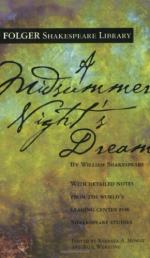|
This section contains 3,044 words (approx. 11 pages at 300 words per page) |

|
SOURCE: "Paradoxical Chastity in A Midsummer Night's Dream," in The University of Dayton Review, Vol. 21, No. 2, Summer, 1991, pp. 153-60.
In the following essay, Liston claims that the Protestant idealization of marriage is a theme of A Midsummer Night's Dream, and that this theme is explored through the conflicting image of the moon as barren or fertile, for example, and through Oberon's restoration of Titania's sight as a signal of "the triumph of chastity over erotic love."
Chastity, said one of the early feminists more than a decade ago, is the only sexual perversion. Neither Shakespeare nor any of his contemporaries would have agreed with her. To the Elizabethans, according to Nancy Cotton Pearse, "Chastity . . . [was] a woman's only honor" (56). And whereas "In the Middle Ages lechery ran a poor and rather venial seventh in the lists of deadly sins," during the Elizabethan period it was second or third...
|
This section contains 3,044 words (approx. 11 pages at 300 words per page) |

|


